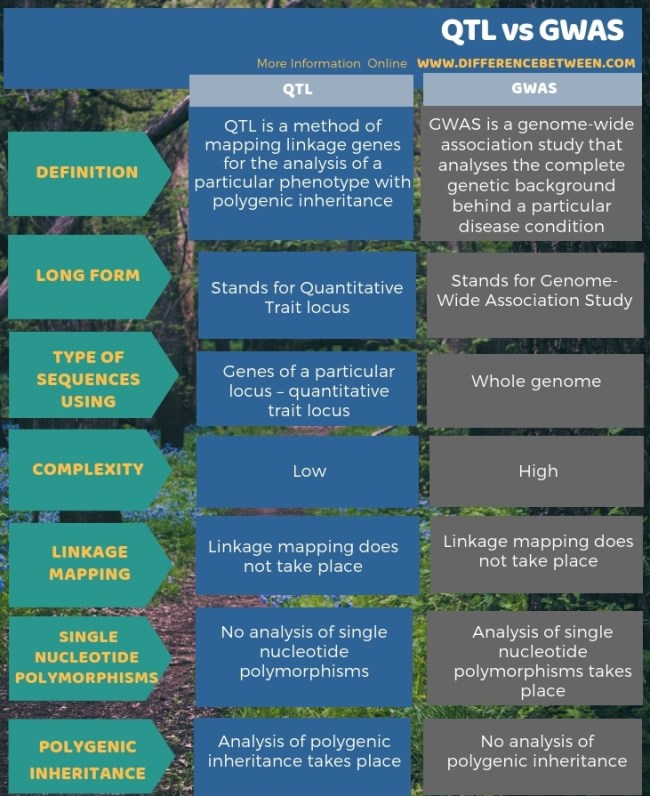Thekey differencebetween QTL and GWAS relies on the type of sequences used in the analysis.QTL uses linkage gene loci to analyzephenotypictraits associated with多基因继承while GWAS useswhole genome sequencesto analyzesingle nucleotide polymorphisms特定条件。
QTL maps and GWAS play an important role in the genetic analyses for different traits. Furthermore, they are important in analyzing various disease conditions with unknown aetiology. In addition, sequencing plays a key role in both techniques. These techniques can further be coupled with other high throughput techniques for increased accuracy and precision.
内容
1.Overview and Key Difference
2.What is QTL
3.什么是GWAS
4.QTL和GWAS之间的相似之处
5.——QTL vs GWA并排比较S in Tabular Form
6。概括
What is QTL?
QTL代表定量性状基因座. It is a region of the DNA associated with a phenotypic trait. Generally, a QTL gives rise to polygenic effects. The distribution of QTLs varies, and the number of QTLs suggests the degree of variation of a particular phenotypic trait. Furthermore, they typically code for underlie continuous traits and not discrete traits.
Upon the identification of the QTL regions, it is important to sequence a particular QTL area. Moreover, to make investigations and research easy, sequencing and storing the sequence data of the common QTL regions take place with the involvement of bioinformatics. We call this technique QTL mapping. Subsequently, a database builds up with the QTL region sequences.

图01:QTL扫描
Furthermore, the applications of QTL sequences rely mainly on BLAST tool, where the sequence similarity can be determined. It is important in deducing relationships between organisms. Furthermore, it is important in determining the complexity of a particular polygenic phenotype. It also determines the evolution of a particular trait.
At present, QTL analysis is combined with other high throughput techniques like DNA microarrays. This is important in the expression analysis of the phenotype. Currently, scientists are much interested in developing the QTL database since QTL regions are responsible for many important traits of different species.
GWAS是什么?
GWAS代表Genome Wide Association Study. It also refers to whole genome association studies. These studies focus mainly on observational studies. It analyses the genetic variants of different individuals usually associated with a specific trait. Moreover, the whole genome is important for GWAS analysis.

Figure 02: GWAS
GWAS is an important tool in the analysis of single nucleotide polymorphisms associated with various disease conditions. This is also a comparative study of the different single nucleotide polymorphisms across a wide population. In addition, the study sample of GWAS is very high; hence, it also takes the format of a cross-sectional cohort study.
Furthermore, the first GWAS study took place with regard to myocardial infarction and analyzing the genes associated with myocardial infarction. At present, GWAS plays an important role in determining the genetic background of complex diseases with unknown aetiology.
What are the Similarities Between QTL and GWAS?
- 他们依靠DNA序列数据进行分析。
- 两者都与各种字符的遗传背景有关。
- Furthermore, they require bioinformatics tools to deduce and interpret results.
- 它们是在大量人群上完成的。
What is the Difference Between QTL and GWAS?
QTL使用链接的基因基因座分析与多基因遗传有关的表型性状,而GWAS则使用整个基因组序列分析了特定条件的单核苷酸多态性。因此,这是QTL和GWAS之间的关键区别。QTL映射比GWAS相对复杂,因为它需要整个基因组测序。
The below infographic summarizes the difference between QTL and GWAS in tabular form.
概括– QTL vs GWAS
QTL映射和GWA在确定各种表型特征的遗传背景方面起着重要作用。它们还有助于分析不同疾病的遗传背景。QTL映射映射负责连续特征的连锁基因,还涉及映射多基因遗传基因。另一方面,GWAS进行了整个基因组分析单核苷酸多态性。此外,这发生在较大的人群中。因此,这是QTL和GWAS之间差异的摘要。
Reference:
1. Liu,Ruixian等。“ GWAS分析和QTL鉴定纤维质量性状和使用富集的高密度SNP标记物在高地棉中的成分。”植物科学领域,Frontiers Media S.A.,2018年9月13日,Available here.
2.“ GWAS vs.QTL映射?”最新的帖子,Available here.
Image Courtesy:
1. “Example of a Genome-wide QTL-Scan from PLoS Biology” By – Styrkarsdottir U, Cazier JB, Kong A, Rolfsson O, Larsen H, et al. (2003) Linkage of Osteoporosis to Chromosome 20p12 and Association to BMP2. PLoS Biol 1(3): e69(CC BY 2.5)viaCommons Wikimedia
2. Bush WS和Moore JH - Bush WS,Moore JH(2012)第11章:全基因组协会研究的“ GWAS疾病等位基因效应”。PLOS Comput Biol 8(12):E1002822。doi:10.1371/journal.pcbi.1002822,(CC BY 2.5)viaCommons Wikimedia


发表评论